Evolution & Informatization of Civilization
Cat: ICT
Pub: 2002
Shumpei Kumon
01630u/18205r
Title
Evolution & Informatization of Civilization
文明の進化と情報化
Author
Shumpei
Kumon
公文俊平
Place
IECP
Reading Circle, Glocom
IECP Reading Circle, Glocom
Time
May-Jun. 2001
2001年5-6月
Index
- Culture & Civilization:
- Religious Civilization & Modern Civilization:
- S-shape wave & Three Phases of Modernization:
- Informatization as the Third Phase of Modernization ('Knowledge Industrialization'):
- Industrialization & Informatization from inside:
- Turning-point of IT Revolution:
- Q & A at the reading circle:
Tag
; ; Conviviality; Empowerment; First 100 feet; Fractal structure; GFN; iCC; Knowledge game; Knowledge industry; Locality of communication; Phenotype; Sigmoid curve; Taxonomy; Wit;
Point
- Reading circle at IECP (Interprise-Enterprise Collaboration
Project) of Glocom was held twice in May and June, 2001 lectured by
Prof. Shumpei Kumon, Executive Director of Glocom. The theme was "Evolution
and Informatization of Civilization" based of his recently published
book, which is update his preceding book of "Theory of Information
Civilization" in 1994.
- >Top Assist Prof. Tadamasa Kimura comments in Kyoto Shim bun at May 6, 2001, "The author tries to describe microscopically
the phenomenon of "Informatization" in context of historical
evolution of several hundred length of civilizations." He
has been an authoritative social scientist in Japan who acknowledges
the importance of the Internet since early 1990s. The recently
published book summarizes and refines the former book published
in 1994; this will be a good guide book which can leads the readers
into "Kumon's theory of civilization."
- Prof. Toshio Watanabe writes in Chuo Koron of
June, 2001, "He challenges to visualize uncertain age and
concept called Information Revolution or Informatized Industry
into a spectacular convincing story. Could he only hear the footsteps
of the unseen new age?"
- 2001年5月と6月に2回に亘り、国際大学Glocom公文俊平所長によるi-Civil研究会とIECPとの合同の読書会があった。本書は、"情報文明論"(1994)の続編として、その後の大きな社会変化を踏まえて書かれたIT革命の文明論である。
- 京都新聞2001年5月6日付の木村忠正氏の書評では、『著者は数百年単位という巨視的な視点から、文明の歴史的進化における"情報化"をとらえようと試みる。... 1990年代初頭から日本の社会科学者としては例外的にインターネットの重要性を喝破していた第一人者だ。1994年の大著"情報文明論"のエッセンスが洗練されて織り込まれ、同著以降のネット社会に関する思索を簡潔に伝えてくれる本書は”公文文明論”への格好の入門書となるだろう。』
- 中央公論2001年6月号の渡辺利夫氏の書評では、『情報革命とか情報産業化とかいって概念のなお定まらぬ不確かな時代と社会を対象にして、こうまで壮大な体系化を試みようとする著者の気概には圧倒的なものがある。まだ来ぬ時代の足音が著者にだけは聞こえるのであろうか。』
Summary
要約
>Top 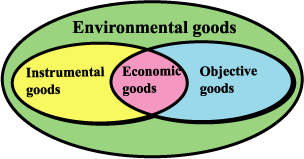 1. Culture & Civilization:
1. Culture & Civilization:
- We consider a system of human society as an aggregation which
has common culture and the subject (=persons and organization) who
constitutes society and civilization. Here 'wealth' or
'goods' is defined as general term for the things which
the subject evaluates in order of preference. Such goods can be
segmented into 'objective goods' whose situation we
can alter, and 'instrumental goods' which we can use
as a means. Both objective goods and instrumental goods constitute
'economic goods.' By the way, it is appropriate to
call 'environmental goods' which belong to neither
of objective nor instrumental goods.
- The subject holds responsibility of external effect to the other
subject by selecting a kind of freedom (among alternative actions).
Furthermore, the subject has his or her own ability of self-recognition
and self-reorganization by reviewing and revising what he or she
recognized, evaluated or acted. The integration of multiple or compound
subjects will constitute 'social system'; where the
subjects are obvious like a nation, a corporation or a netizen industry,
or are not obvious like global community, a market or netizen field.
- >Top Herein, I would try to understand the concept of culture and civilization
on the analogy of biological terms: what culture (composed of each
cultural factor) are to 'genotype', civilization (composed
of each civilization factor) are to 'phenotype.' However
outcome of civilization receives a great deal of influence of not
only genotype of the culture, but also of the external effects as
well as the internal environment such as adoption of a particular
policies or plans by the constituents. (However, this does not mean
culture is transmitted genetically. Culture is not the genotype
itself, but is transmitted with acquired character, usually without
any self-consciousness or self-reflection.)
- >Top Now It is called 'IT revolution' in Japan to express such total
changes occurred in many spheres from technology and industry to
economics, politics and various social reforms. According to the taxonomy of theory of civilization, we can distinguish such IT revolution
into two different aspects, which further articulated into two sub-aspects;
totally four different
segmentation as follows:
- IT Revolution constitutes of:
- 1. Further progress of industrialization ('Super-industrialization')
- 2. Social change surpassing industrialization ('Trans-industrialization')
- Therefore, each aspect can be subdivided as:
- 1-1: Maturity of the second Industrial Revolution (Japan
is in this stage.)
- 1-2: Breakthrough of the third Industrial Revolution (may be recognized yet)
- 2-1: Advent of Information Civilization as the third
aspect of Modernization.
- 2-2: Advent of Knowledge Civilization as a new civilization
surpassed Modern Civilization
- Here we would outline each aspect in the following chapters:
1. 文化と文明:
- システムとしての人間社会は"共通の文化と文明をもつ主体 (社会を構成する個人や組織)の集まり"と考える。ここで主体による評価 (望ましさの順序づけ)の対象となる事物のことを財と総称する。財は、その状態変更できる目標財と、それを使用できる手段財がある。目標財かつ手段財は経済財と呼ぶ。他方、目標財でも手段財でもない財は環境財と呼ぶのが適切である。
- 主体は、自らの"自由" (可択的な行為の中からの選択)を行使することによって、"他の主体"に対して"外部効果"を及ぼすことの"責任"を問われる。さらに主体は、自らの認識、評価、行為を反省し、修正しようとする"自己認識"と"自己再組織"能力を持っている。複数の主体(複合主体)を構成する全体が"社会システム"である。この場合の社会システムはそれ自体が複合主体である場合(国家、企業、智業)と、それと見なせないもの(国際社会、市場、智場)とがある。
- ここでは文化と文明の概念を、生物学のアナロジーで理解する。即ち、文化(その個々の要素は文化子)は遺伝子型(genotype)であり、文明(その要素は文明素) 表現型(phenotype)に相当する。ただし、文明の現れ方は、文化という遺伝子因子の影響に加え、外的影響のみならず内的環境(社会構成員の政策・計画など)の影響をも受ける度合いが大きい。(但し、そのことは文化が遺伝的に伝達されることを意味しない。文化は遺伝子型そのものではなく、後天的に伝達されていく。文化の伝達過程は、反省を必要としないという意味で、ほとんど無意識的に行われる。)
- 近年急激に進行中の、技術・産業から経済・政治・社会全般におよび大きな社会的変化は、2000年以来、日本では"IT革命"と呼ばれるようになった。だが、文明論的taxonomy (分類枠) によれば、このIT革命には2つの異なる側面、いやさらに細分すれば計4つの異なる側面がある。
- 即ち、IT革命には、
- 1. 産業化の一層の進展 (スーパー産業化)
- 2. 産業化を超える社会変化(トランス産業化)
としての側面がある。
さらにこれらを細分化すると
- 1-1: 第二次産業革命の爛熟 (日本ではこの面は強い)
- 1-2: 第三次産業革命の突破 (まだ理解が不十分)
- 2-1: 近代化の第三の局面としての情報化 (情報文明) の出現
- 2-2: 近代文明を超える新文明としての智識文明の出現の側面がある。以下、その各々を概観する。
>Top 2. Religious Civilization & Modern Civilization:
-
There are two major group
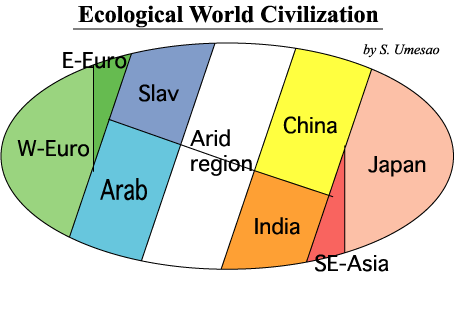 of civilizations in
the today's world: one is the group of religious civilizations
spreading out in the dried central part of Eurasia continent,
and the other is of modern civilizations located in both outskirts
of east and west of the former; in Japan and in Western Europe
(extended as far as North America) (Described by Tadao Umesao in his book of 'Ecological history of civilizations.')
of civilizations in
the today's world: one is the group of religious civilizations
spreading out in the dried central part of Eurasia continent,
and the other is of modern civilizations located in both outskirts
of east and west of the former; in Japan and in Western Europe
(extended as far as North America) (Described by Tadao Umesao in his book of 'Ecological history of civilizations.')
- >Top In 9th and 10th century, Western Europe became independent from
Roman Empire, while Japan from Chinese Sui and Tang dynasties (though Yamoto Japan originally emulated Chinese
political system.) Modern civilizations of both areas were enforced
to evolve by the appearance of Mongolian Yuan dynasty in
13th century. The Mongols integrated for the first time the four
religious civilizations in Eurasia continent; 1) Chinese Taoist
civilization, 2) Indian Hindu civilization, 3) Oriental Islamic
civilization, and 4) Slavic Greek Orthodox civilization. Thus the
world history has begun for the first time.
- "Military and Great Voyages revolution' occurred as the first
Modern Civilization both in Western Europe and in Japan during 15-16th
centuries could be understood as counter movements against the sudden
emergence of the new Mongolian world empire in Eurasia continent.
Such modern civilizations could attain to south-east Asia via sea
route and acquire various goods from the religious civilization
there.
- During such process Western Europe happened to discover the new
continent, and could transplant its modern civilization in the manner
of pure cultivation. Hence after the latter half of 16th century
the Modern Civilization could enter the full-scale of advent aspect
with establishment of the modern sovereign nations under the absolute
monarchy.
- The features of Religious Civilization and Modern Civilization are:
- Religious Civilization: past-centric, continuation-oriented
civilization: emphasis on semantics or value of world and life,
and on knowledge pursuing the object.
- >Top Modern Civilization: future-centric, development-oriented
civilization: emphasis on process or acquisition of powers, rather
than the object itself.
- Basic culture of Modern Civilization is composed of ideology
of progressivism, processionalism, liberalism
- Process of Modern Civilization is none other than process
of 'empowerment' to attain to the object.
2. 宗教文明と近代文明:
- 今日の世界には2つの主要な文明群が存在する。ユーラシア大陸の中央部の乾燥地域に広がる宗教文明群と、その東西の周辺にあたる日本と西欧"北米にまで広がる"近代文明群である。(梅棹忠夫の"文明生態史観")
- 9-10世紀に、ローマ帝国や随・唐帝国 (そのコピーとしての大和の律令国家)からの自立を通じて出現しつつあった西欧と日本の近代文明にとって、さらなる進化の挑戦となったのは、13世紀のモンゴル帝国の出現であった。モンゴル帝国は、ユーラシア大陸の4つの宗教文明(中国の道教文明、インドのヒンズー教文明、オリエントのイスラム教文明、スラブのギリシャ正教文明)を統一して初めて、世界史の出発点を作った。
- ユーラシア大陸に忽然と出現したこの新世界帝国の挑戦に対する初期近代文明の応戦とでも言うべきものが、15-16世紀にかけての西欧と日本に生じた”軍事・航海革命”であり、近代文明社会はそれによって海路南・東南アジアに到達して宗教文明の文物を入手した。
- その課程で、”新大陸”を群善発見して、そこに近代文明のほとんど純粋培養的に移植できた。こうして、近代文明は、16世紀後半以来、絶対王制の下での近代主権国家の確立と共に、その本格的な出現局面に入るのである。
- 宗教文明と近代文明の特徴は、
- 宗教文明:
過去準拠、存続志向型の文明。世界や人生に意味や価値、目標についての知識を重視。
- 近代文明:
未来準拠、発展志向型の文明。目標よりはむしろそれを実現するための手段ないしパワーの獲得を重視。
- その根底にある近代主義の文化は、進歩主義、手段主義、自由主義の3つの柱からなる信念体系。
- 近代文明の進化過程、つまり近代化課程は、目標を実現する力の不断の増進過程("Empowerment")。
>Top 3. S-shape Wave & Three Phases of Modernization:
- The model of "S-shape wave"
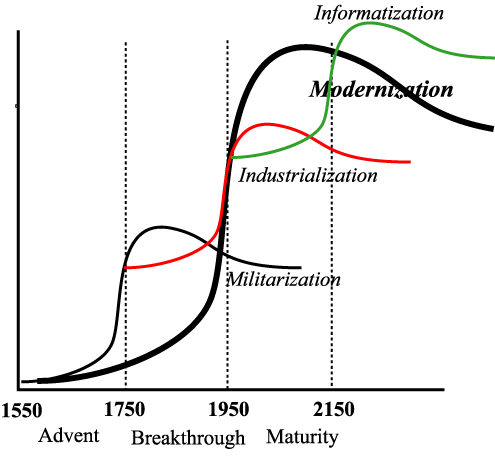 (sigmoid curve) can properly
explain the social changes composed of three phases of 1) 'advent',
2) 'breakthrough', and 3) 'maturity.' The original
idea of this S-shape wave comes from cumulative distribution curve
or logistic curve which causes overshooting at its maturity phase,
then after some adjustment it attains to its plateau state. Here,
the horizontal axis is Time, and the vertical axis means
a kind of vitality of progress or result.
(sigmoid curve) can properly
explain the social changes composed of three phases of 1) 'advent',
2) 'breakthrough', and 3) 'maturity.' The original
idea of this S-shape wave comes from cumulative distribution curve
or logistic curve which causes overshooting at its maturity phase,
then after some adjustment it attains to its plateau state. Here,
the horizontal axis is Time, and the vertical axis means
a kind of vitality of progress or result.
- >Top <Fig.1>
During process of the social changes, a certain S-shape
wave accompanies the subsequent S-shape wave, which overlaps the
former wave; i.e., when the former S-shape wave enters maturity
phase, the next wave appears as advent phase, and so on. Also each
phase (advent, breakthrough, and maturity) of a bigger S-shape wave
contains corresponding smaller S-shape waves as the following illustration.
Such social changes tend to constitute fractal structure'
- The process toward modernization entered full-scale advent phase
from the second half of 16th century, then almost bicentennially subsequent
waves of breakthrough and maturity followed.
- The First Phase of Modernization (advent phase) is
also phase of ■militarization which increases military threat
or compulsion, where modern sovereign nation and its member (subject,
then national) were formed. Militarization is none other than the
process of nationalization. Modern sovereign state consecrates
the concept of national sovereignty (=public authority), and participate
in the contest or 'power game' for increase or boost of national
prestige (=general threat and compulsion). "Realization of
peace by struggle" will be the principle of this phase.
- Western Europe:
where international consensus was established to allow exchange
of either or both of 1) nation's armed forces (=exclusive
possession of military power by nation) and/or 2) territory (=land and people, partly or wholly, where sovereignty prevails)
with other nation state under a certain rule.
3. S字波モデルと近代化の3局面:
- 社会変化の過程を1) 出現、2) 突破、3)成熟の3局面からなる”S字波”の概念モデルを使って把握する。このS字波の原型は累積分布曲線あるいはロジスティックカーブ型というよう、成熟局面でオーバーシュートを引き起こし、その是正の後に高原状態に到達するというような形の波である。
- <図1>
社会変化の過程では、同じようなS字波が一部重複を伴いながら、つまり、前のS字波が成熟局面に入る頃に、新しいS字波が出現してくるというように、次々に継起したり、一つのおおきなS字波の各局面 (出現、突破、成熟) のそれぞれに対応するさらに小さなS字波が見られること
(社会変化はフラクタル構造を成している。) は十分考えられる。
- この図でいう近代化過程は、16世紀後半から出現局面に入り、以後ほぼ200年毎に突破から成熟への局面転換が起こる。
- 近代化の第一局面(出現局面) は、■軍事力
(脅迫・強制力)の増進する軍事化 (軍事革命) の局面であって、そこでは近代主権国家とそのメンバー(臣民、後に国民)
の形成が見られる。つまり、軍事化は同時に国家化でもある。
国家主権 (公権) の概念を神聖化する近代主権国家は、国際社会を舞台にして、国威 (一般的脅迫・強制力) の増進・発揚競争(威のゲーム)
に参加する。"闘争を通じての平和の実現"が、この局面での指導理念となる。
- 西欧の場合:
軍事化過程の原動力となったのは、国軍力(=国家による軍事力の独占的保有・行使) と、領分化(=自らの主権の及ぶ範囲の土地と人民 (の少なくとも一部) を一定のルール下で、他国と交換・分合を許すという国際的規約の形成。
- >Top Japan:
where nation armed forces was made incompletely; possession
of land and people by Daimyo (feudal load), who were
subordinate of Tokugawa Shogunate, was strengthened through
relocation or abolition of Daimyo.
- The Second Phase of Modernization is a phase of ■industrialization (=industrial revolution) which increases economic power (=transaction
and exploitation), where modern industrial corporation and citizen
of its members were born. That is, industrialization is none but corporationization. Modern industrial corporation consecrates
concept of private property (=private right), and participate in
the contest or 'wealth game' for accumulation of wealth (general
transaction or exploitation). "Realization of prosperity by
competition" will be the principle of this phase.
- Western Europe:
where mechanization (=partial replace of action by machine)
and comodification (=partial replace of action by other
people, i.e., exchange principle of goods/services made by us
with those made by others) are two driving forces for the industrialization.
- Japan:
where mechanization was incomplete until the second encounter
with Western European civilization in the latter half of 19th
century. Instead 'Diligence & Discipline Revolution' likely
prevailed in Japan.
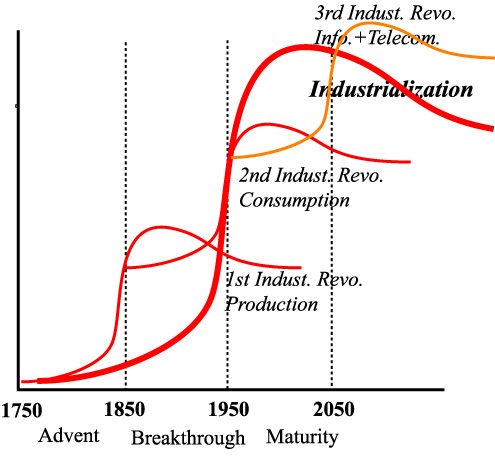 <Fig.2>
<Fig.2>
- >Top The Third Phase of Modernization is a phase of ■informatization (=information revolution) which increases information power (=persuasion
and inducement), where information industry and netizen of its members
are born, and participate in the contest of 'knowledge game' for acquisition and display of knowledge. "Realization of conviviality by collaboration" will be the principle of this phase.
Digitalization (=rendering bit information) and Common
usage (=unilateral diffusion of information and knowledge) become
two driving forces for the informatization.
- The following left chart shows "S-shape wave of industrialization
and Industrial revolution", which consists of smaller
S-shape waves expressing 1) the first industrial revolution:
mainly featured with production, 2) the second industrial
revolution: consumption, and 3) the third industrialization: information & telecommunication.
- >Top
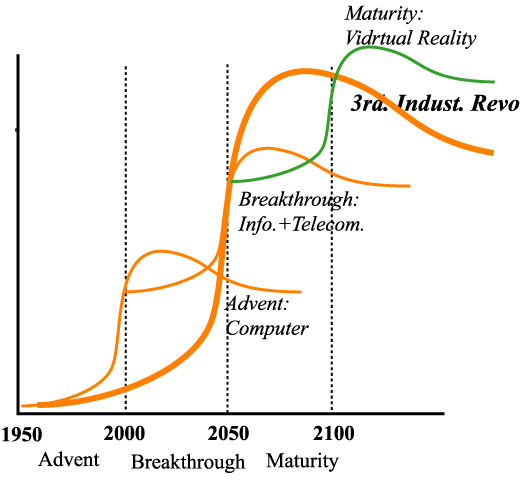 <Fig.3>
<Fig.3>
- The right chart magnified the third smaller S-shape wave to express further smaller S-shape waves,
which represent 1) advent of computer industry, 2) breakthrough
of information & telecom industry, and to expect 3) forthcoming
maturity of fruits of the industrial revolution ('super industrialization' like ubiquitous appliances of home electronics) which will continue
for a while. In addition, in this phase device-to-device (D2D, Device-to-Device)
communication such as virtual reality, artificial networked agent
(artificial life), or embedded micro information terminals in clothes
or body may surpass information recognized through our real five
senses.
- 日本の場合:
国軍化ははなはだ不徹底にしか進行しなかったが、徳川国家の下位主体としての大名が保有する土地や人民の領分化は、国替えや改易の形で徹底的に進められた。
- 近代化の第二局面は、■経済力 (取引・搾取力) の増進する産業化 (産業革命) の局面であって、そこでは、近代産業企業とそのメンバー (市民)
の形成が見られる。つまり、産業化は同時に企業化でもある。私有財産権 (私権) の観念を神聖視する近代産業企業は、世界市場を舞台にして、富
(一般的取引・搾取力)の蓄積・誇示競争 (富のゲーム) に参加する。"競争を通じての繁栄の実現"が、この局面での指導理念となる。
- 西欧の場合:
機械化(=行為の一部を機械による代行)と、商品化(=行為の一部の他人による代行、即ち、自ら生み出す財・サービスは最初から他人が生み出した財・サービスと交換することが前提)の2つが産業化の原動力となった。
- 日本の場合:
少なくとも19世紀後半の西欧近代文明との第二次邂逅に至るまでは、機械化は不徹底で、むしろ勤勉革命が進行。
- 近代化の第三局面は、情報力(説得・誘導力)の増進する。情報化 (情報革命)の局面であって、情報智業とそのメンバー(智民)が智の獲得・発揮・競争(智のゲーム)に参加する。智民にとっての指導理念は共愉(conviviality)の実現である。情報化の原動力となるのは、情報や知識のデジタル化(ビット化)と、通識化(情報や知識を一方的な普及・通有の対象とする)の2つになる。
- <図2> は、
産業化と産業革命のS字波であり、
第一次産業革命:生産、
第二次産業革命:消費、
第三次産業革命:情報通信
の3つの小さなS字波からなる。
- <図3>は、
この内の3番目の小S字波を拡大し、より小さなS字波を表現した。それらは、コンピュータ産業の出現、情報通信産業による突破を経て、産業革命の成果を取り入れた成熟局面 (情報家電化のようなスーパー産業化)はまだ相当期間続く。さらにこの局面では、バーチャル・リアリティやネットワーク上のエージェント (人工生命)、あるいはミクロ化した情報端末が衣服や肉体に埋め込まれ、そうした機械間の通信
(D2D, Device-to-Device) が、我々の五感経由を凌駕するようになると思われる。
>Top
4. Informatization as the Third Phase of Modernization:
- Information revolution can be also estimated in three phases of
S-shape waves. First, the first Information Revolution appeared in 1950, concurrently proceeding with the
third Industrial revolution. The new type of organization emerged; such as NGO-NPO different
from the conventional nation or corporation, being established 'knowledge
industry' aiming to acquire knowledge which is an ability of
abstract or general persuasion and induction.
- >Top David Reed proposes the concept of GFN (Group Forming Network),
which assists to form varied group activities. Here P2P application
(peerware) functions to
 strengthen
such collaborative activities.
strengthen
such collaborative activities.
- How could we estimate value of the network? In case of
mass media, the value is proportional to the number of subscribers
(N), and in case of personal communication, it is proportional
to the square of N, and finally in case of group communication,
it grows exponentially with of N. Program content is important
in mass media, and in the latter communications value of the contents
become smaller; consequently so-called killer applications grow
from GFN activities.
- >Top Recent trend shows that infrastructure prepared for large corporations
is featured as IP network, or VPN (=Virtual Private Network)
and computer-reinforced facilities like iDC (=Internet Data
Center) trouble-free in power supply, earthquake, and security.
These facilities are used as an infrastructure for the third Industrial
Revolution, mostly concentrated in major cities, but on the hand,
wide network environment also is growing in the form of iCC (Internet
Community Center) or CAN (Community Area Network). Typical
examples can be observed in Canada as the condominium method aiming
to self-operate regional network for mutual connection by renting
dark fibers, and in Asia as public Internet based on broadband wireless
LAN.
4. 近代化の第三局面としての情報化:
- 情報化のS字波は、やはり三次に亘ると思われる情報革命から成ると想像される。まず、1950年から出現した第一次情報革命は、第三次産業革命と同時進行しつつ、従来の国家や企業とは異なる"智=抽象的・一般的な説得・誘導力"の獲得と発揮を目指す智業が台頭した。
- aN+bN2+c2N
- David ReedのいうGFN (Group Forming Network)をプラットフォームとする多種多様なグループが形成され、インターネットはそれらのグループが交流・共同活動を推進するためのインフラとなる。
- ネットワークの価値はどう捉えるべきか?それは、マスメディアの場合は加入者数Nの倍数で、パーソナルコミュニケーションではN2で、そしてグループコミュニケーションでは2Nでそれぞれ比例して価値が増大する。番組コンテントが重要なのはマスメディアであって、後者になるほどコンテンツは相対的に価値を失い、キラー・アプリケーションもグループ活動支援型の中から登場してくる。
- 近年見られる大企業用のIPネットワーク(VPN) や電源・耐震・セキュリティを強化した電脳都市 (idcなど)
は、第三次産業革命のためのインフラとして大都市集中傾向が進む一方で、その外側に各地域で共同利用型の大きなネットワーク (icc=Internet
Community Center) やCAN=Community Area Network) が登場する。
(例:カナダのようにダークファイバを借りて相互接続の地域ネットワークの自主運用を目指すコンドミニアム方式、あるいは今年から各国に爆発的に拡大し始めた広帯域無線LANベースの公衆インターネットなど。)
-
>Top <After the Second Information Revolution> <Fig.4>
- >Top We can assume the second Information
Revolution
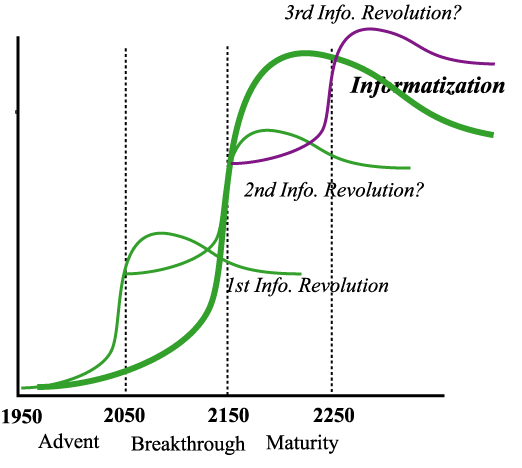 which will appear around 2050; where various
group of netizens will concentrate to discover and diffuse better objects (=value of life and meaning of the world, etc.) through 'Knowledge game' rather
than to pursue the better means.
which will appear around 2050; where various
group of netizens will concentrate to discover and diffuse better objects (=value of life and meaning of the world, etc.) through 'Knowledge game' rather
than to pursue the better means.
- From around 2150 the third Information
Revolution starts; single or small number of knowledge
industries can realize to integrate various outlooks of world or
senses of values, emerging as a full-scale of Knowledge
Civilization featured with past-centric, continuation-oriented,
which is different from modern civilization.
- <Fig.5>
-
<第二次情報革命以降>
- <図4>これに続く2050年頃から出現する第二次情報革命を想定すれば、その中心は様々なグループ
(智業)によって、優れた手段よりは優れた目標 (人生や世界の意味・価値) を発見し普及させる本格的な「智のゲーム」がみられるようになろう。
- <図5>さらにそれに続く2150年頃からの第三次情報革命では、ついに一個あるは少数の智業による世界観・価値観の間の大統合が実現するようになり、それと共に、近代文明とは異質の文明、即ち過去準拠・存続志向型の智識文明が本格的に出現してくることだろう。
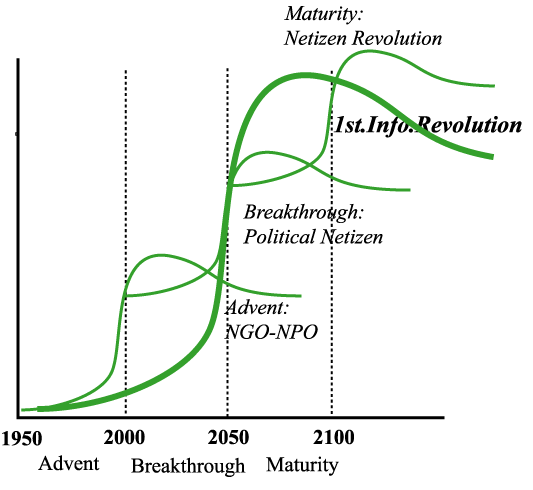
>Top 5. Industrialization & Informatization
from inside:
- "Global Path" and "Glocal Path": these
are two different trends in the third Industrial Revolution: (NB:
Glocal = Global + Local)
- "Global Path":
During advent and breakthrough of the second Industrial Revolution
(=Heavy and chemical industry revolution), the major trend had
been construction of new social infrastructure like electricity,
telephone, and network of roads, as well as supply of new commodities
and serviced by reengineering process of large corporations.
Similarly, in the breakthrough phase of the third Industrial
Revolution it will be a necessary trend that new leading industries
involved in construction of IT infrastructure, industrial organization
adopted new type of management, and new technology and services
applicable to business sphere. In particular to telecommunication
infrastructure, it will be major trend that mesh network of WDM (Wavelengh Division Multiplexing) type of optical
fiber, and optical switching of IP packet (=IP over glass).
Also multi-to-multi always-on data communication (D2D)
is merging, though which had been niche until now. All conventional
telephone will change to IP telephone, and even present broadcasting
will also become IP multicast services.
- >Top "Glocal Path":
People who experienced change of consciousness and behavior
patterns by intelligent empowerment begin to enhance informitization
and industrialization from inside, collaborated with also empowered
government and corporations. Multi-to-multi bilateral and symmetrical
always-on network will be realized starting from mutual connection
of local LANs as border of WAN. George Gilder points out that
"Law of locality of communication"; 80% traffic occurs
inside the community, so community network should be broadbanded.
We should start from "the first 100 feet" than "the
last one mile" in installing optical fiber cable; and affluent
local capacity can rent to others and furnish CSP (=CAN
Service Provider) services for the community.
- >Top Psychological viewpoint of "Informatization from inside";
focusing the first Information Revolution,
- In the physical space, a specific person shares
only a negligible singular point. But in the inner part of his
or her brain, we can find the reversed 'information space': which is occupied with full of his or her personal information,
particular information commonly shared among family or workplace,
then open information in local, nation, and finally global information.

5. 内からの産業化・情報化:
- グローバル・パスとグローカル・パス: 第三次産業革命の流れに、2つの異質な流れが生じている。
- グローバル・パス:
第二次産業革命 (重化学工業革命)の出現から突破にかけても、電力・電話・道路網のような新社会インフラや株式会社のような大規模経営形態の出現による新たな商品・サービス導入のリエンジニアリングだった。
同様に、第三次産業革命の突破局面では、新しいインフラと主導産業、新しい経営および産業組織形態、新しい技術・財サービスのビジネス利用が不可欠である。特に通信インフラでは、WDM型の光フィアバがメッシュ状に引かれ、IP化されたパケットが光ルーティングによってスイッチされていく"IP
over glass"が通信の主流となる。これまではニッチであった機械間通信 (D2D)を中心に多対多常時接続型のデータ通信システムであって、従来の電話はIP電話に、放送はIPマルチキャストが台頭してくる。
- グローカル・パス:
知的Empowermentを基盤とする意識や行動様式の変化を経験しつつある智民が、同じく知的Empowermentを達成しつつある政府や企業との協業を通じて、地域コミュニティの内からの情報化や産業化を推進する。WANの縁、LANから出発した多対多の双方向・対称型・常時接続ネットワーク。
"通信の局所性の法則"(George Gilder)、即ち、コミュニティ内の通信が全体の80%。回線は末端ほど太くなるべき。Last
one mileではなく、First 100 feetであるべき。一度に沢山引いておいて、余分は融通または有料貸する。CSP (CAN
Service Provider)コミュニティ内の各種ユーザサービス。
- 内からの情報化: 第一次情報革命に着目すると
- 物理空間の中で、特定の個人が占める位置は、その中の一点に過ぎないほど微少。しかし、個人の脳の内部の情報空間に分け入ってみるとこの関係は逆転する。即ち、個人だけが持っている情報、家族や職場内だけに開示する情報、地域や国や世界に対して開示してよい情報に区分できる。
-
>Top "Intelligent empowerment":
- How does the informatization, or, intelligent empowerment
effectuate to the 'personal information space''? Expansion of
the above right schema occurs according to the intelligent empowerment.
The same expansion occurs in case of corporations or state.
First of all communication technology is used to enhance their
own intelligent empowerment; mainly for the internal process
and mutual transaction among business partners. ('Web life style,
or P2P life style) Thus it is particularly important to intend
to pursue 'inside informatization."
- "New new-economy":
- 'new-economy' born during the third Industrial Revolution
is different in its quality from the conventional economy. Profit-making
corporations have supplied commercial goods and services for
the market, but new services by NGO-NPO organization such as
care service or information service for private users should
be defined as "non-commodity" or "quasi-commodity"
Also various trials to circulate local money or eco-money within
the particular community. I would say this will be the birth
of "New new-economy."
- Presently, the number of globally active nations is about
200, and that of global corporations about 20,000, while that
of globally active NGO-NPO exist 2 million.
-
知的エンパワーメント:
- 情報化、即ち知的エンパワーメントは、どのように個人の情報空間に効果を及ぼすか?上右図の個人の情報空間の全体が外に向かって拡大し始めるのが知的エンパワーメントである。同じことは企業や国家についても言える。通信技術の利用はまず自分自身の知的エンパワーメントのために、つまり部内業務や取引相互間の業務連携を効率化するために使われる。(Webライフスタイル、P2Pライフスタイル) 即ち、意図的な努力としての"内なる情報化の進展"が特に重要である。
- ニュー・ニュー・エコノミー:
- 第三次産業革命の過程で生まれる"ニュー・エコノミー"は、従来の経済と質的に異なっている。それは、営利追求企業が媒介してきた市場向けの商品と異なるNGOやNPOによる財やサービス (ケア・サービスや個人相手の情報提供など)いわば"非商品"や"準商品"が行われるようになってきた。コミュニティ内で交換を媒体する局地的な通貨も生まれてきている。いわば"ニュー・ニュー・エコノミー"の誕生である。(リバース・オークションやグループ・バイの仕組みもこの例である。)
- グローバルに活動できる国家の数は約200、多国籍大企業は約2万であるのに対し、グローバルに活動できるNGO/NPOの数は2百万もある
>Top 6. <PS> Turning-point of IT Revolution:
- Borrowing from Russell Ackoff's theory, I would adopt such a methodology
as the 'systematic viewpoint' rather than 'mechanical
viewpoint.': the former stresses 'expansionism', 'structural
thinking', and 'teleological outlook' and observes 'Informatization' as a part of broader 'Modernization', then tries to foresee
the future appearance compared with the preceding 'Militarization'
or'Industrialization', while the latter tends to deduce from
the relation of cause and effect, 'analytical way of thinking' and
'mechanical theories.'
- Though forecast of the future is always vague and ambiguous,
I tried to rather describe it with changeable possibilities which
could be realized by our active involvement, rather than to pursue
logical description about the future. (This attitude can be said
as my own dogmatic assertion or prejudice, but it is synonymous
with my freedom and responsibility of expression.)
- During the process of the first Information Revolution, according
to its process of 'Advent' and 'Breakthrough', new type of group
media (GFN) will emerge, in addition to the conventional mass and
personal medial. People's patterns of behavior change, and a new
type of netizens come out.
- I recently acknowledged that various lawyers, technocrats, financial
and media leaders appeared since 1950s trying to control patents,
copy rights, corporate management and overall economics played as
the initial stage of netizens. While, a new type of netizens represented
by a kind of 'geeks' are also emerging to try to make both of infrastructure
and contents and operate by themselves.
6. <読書会追記>IT革命の転換期:
- 私の"情報文明論"の方法は、ラッセル・アコフの議論を参考にすると、まず機械時代の還元主義、分析的思考、機械論的(還元主義的因果論)的な見方ではなく、逆にシステム時代の拡張主義、構成的思考、目的論的な方法によって、"情報化"という社会変化をより大きな"近代化"の
一部として観察、それに先立つ軍事化や情報化と比較をした上で未来を描こうという点にある。
- また、それが考察の対象としているこれからの情報文明は、我自身がその一部を構成しており、それについての理論的記述は、未来の予言ではなくて、むしろ今後の我々自身の主体的な行為を通じて実現できる可能性を示そうとしている。
- 第一情報革命の中では、その出現から突破への転換に伴って、従来のマス/パーソナル・メディアに加えてグループメディア(GFN)が出現してくる中で、人々の行動形態が変わり、新しいタイプのネティズンのネティズンの登場が見られるようになる。
- 最近改めて気づいたことだが、1950年代以来の第一次情報革命の出現期に登場した最初のネティズンは、パテントや著作権、企業経営や経済運営ををコントロールしようとする法律家、テクノクラート、金融やメデ
ィアの支配者だったのではなかったか。それに対し、第一次情報革命の突破期に台頭してきている"ギーク" 達をもその主導者とする新しい種類の智民は、情報通信ネットワークのインフラももコンテンツも自分達で作り、運営しようとしている。
>Top 7. <Q & A at the reading circle>:
- Followings are major questions from the audience and answers from
Prof. S. Kumon, with some portion answer was given from other audience.
Group Forming Networked discussion has already started. Q and A still continue on the net: there will be no end about the
discussion of culture and civilization where we are involved.
- Q: Why
the S-shape wave of the Information Society will not diffuse,
because IT industry is changing by dog-year or mouse-year basis?
- A: Changes in the Information society include abrupt change
and slow one. On the whole the process of informatization could
be applicable by similar S-shape wave taking three phases of process
as the preceding one, and consequently, the speed of the change
looks like more or less the same level.
- Q: What
do you call the S-shape wave after the Informatization?
- A: As long as Modern Civilization concerned, I don't assume
there will be the next S-shape wave after the informatization. The
next new civilization will be past-oriented "Knowledge Civilization"
which is different from the present future-oriented civilization.
- Q: Why
the small S-shape wave has a hundred year cycle?
- A: There is no particular grounds. But as a result we can
observe like that; more correctly almost every century a new small
S-shape wave looks to appear. Though the amplitude varies, the wavelengh
remains rather constant. For example, in case of transportation,
it will take about several hours to travel long distance, but an
hour or so in traveling short, though the moved distance varies
much according to the traffic means.
- >Top Q: Horizontal
axis of S-shape is time (=scalar volume). If the vertical
axis is like 'variation' caused by the empowerment of modern
society, it should be vector volume?
- A: The vertical axis is also scalar volume.
- A from an audience: Also It is likely happen a phase difference
between scalar and vector volume.
- A' from an audience: Saturation of S-shape wave means a
kind of blockade, which may lead to "Death of City" as
I mention....
- Q: Time
is always treated as a denominator in the modern society, which
means shorter time is more efficient. But in postmodern society
time can be treated as a numerator?
- A from an audience:Time as a numerator means a grade of
'fulfillment.' Consider time divided by distance; which means how
fulfilled or satisfactory time has passed during movement of one
kilometer. It would be possible to say that satisfaction equals
to the total of oblivious time.
- A' from an audience: Time should be rather multiplied.
Because multiplication by time can represent degree of value or
quality.
- Comment from an audience: What will be value of the intelligent
output? Without its clear definition, good business will not come
out.
7. <読書会Q&A>:
- 以下は会場からの主な質問とそれに対する公文教授の回答である。一部は会場からの回答もあり、グループ作成ネットワーク的な議論はすでに始まっている。なお、Q&Aはまだネットワークで続いている。我々が含まれる文化と文明の議論に終わりはない。
- Q:ドッグイヤーやマウスイヤーのような指数関数的な変化で、情報社会はS字波
が拡散しないか?
- A:変化の急激なもの、そうでないものが混在している。全体としては、S字波は弾力的に現実に当てはめれば、情報化の過程もこれまでと同様にS字波のような三つの局面を通過しつつ、変化は全体としてこれまでとほぼ同じ速度で進行していると見ることができるのではないか。
- Q:情報化の次のS字波は何と呼ぶか?
- A:近代文明に関する限り、情報化の次に匹敵するS字波はないと想像している。次に来るのは、未来志向型とは質的に異なる過去準拠型の新文明 (智識文明)となるという仮説だ。
- Q:なぜ小さなS字波は100年周期か?
- A:その根拠は特にないが、これまでの近代化過程を観察した結果としてそう言えそうだ。正確にいえば、ほぼ100年置きに、新しい小S字波が生まれてくるように見える。また周期の中での変化
レベルというか質が異なってくるとしても、周期そのものはさほど変わらない。乗り物でいえば、長距離なら数時間、短距離なら1時間前後といった時間間隔はそれほど違わないにしても、移動距離は大きく違ってくる。
- Q:S字波の横軸は時間 (スカラー量) だが、縦軸は変化量 (近代社会の変化量=エンパワー)を示すベクトル量ではないか?
- A:縦軸もスカラー量と想定している。
- 会場A:ベクトル量とスカラー量では位相も違いが出てくる。
- 会場A':S字波のSaturationは、リアルな状況の閉塞であり、それは"都市の死" に相当するのでは。
- Q:分母に時間変数が入るのが近代の特徴 (=分母が小さいと効率が良い)とすれば、ポストモダンでは時間はむしろ分子にならないか?
- 会場A:時間を分子に置くとむしろ"充実度"を示す。時間・距離は即ち、1Kmをどれだけ充実した時間を持てるかという発想。あるいは満足とは忘れた時間ともいえる。
- 会場A':時間は掛け算という考えもある。つまり時間をかけた方が価値が高いという考えだ。
- 会場コメント:知的生産物の対価はどうなるのか?それなくしては良いビジネスが 生まれない。
- >Top Q: I
think the cyber space does not belong to the real space. Can these
two kinds of space coexist as different two fields of activity?
- A: They can coexist actually. The cyber space is usually
considered to have less physical and less social restriction, but
has more technical restriction due to communication technology and
security problem, etc. Conversely, smaller social restriction in
the cyber space may cause phenomenon of confinement or addiction.
Certain level of restriction from the real community (local community)
may be essential.
- Q: During
the process of the third Industrial Revolution, leveling of wealth
looks far from the solution. How do you forecast this?
- A: During the maturity phase of Militarization (=concurrently
the advent phase of Industrialization), political leveling of the
national right like suffrage is more focused than the leveling of
distribution of wealth. While, during the maturity of Industrialization
(=concurrently the advent of Informatization), leveling of political
right will not be focused (like actual unleveling of right due to
easy abstention of right.). Generally speaking, each phase of Modernization
during the process from its advent to breakthrough, the proper value
of each phase (=the power progress in each particular phase) seems
to be mainly focussed by the people who require equal right; i.e.,
democratic request in the militarized society, and leveling of wealth
in the industrialized society. Digital Divide issue in the Information
society of 21st century could be an similar egalitarian request.
- Q: Can
I understand that the past-centric, continuation-oriented Knowledge
Civilization is "wisdom of teleology"? If so, is it 'apriori
wisdom' or 'empirical wisdom'? Further, is it 'contradictory world'
or 'non-contradictory world.'?
- A: The philosophy of Knowledge Civilization may be based
on 'apriori wisdom.' Or I would say all philosophy could be apriori
wisdom. At the moment, I cannot prepare proper answer whether it
is contradictory or non-contradictory world.
- >Top Q: Can
a civilization develop as 'atavism'? Further, Do the Japanese
lack in software development because of genetic character?
- A: We can observe the success story of a certain age may
result insufficiency in adaptation in the next age. In 1980s Japan
succeeded in overcoming oil crisis, while in 1990s US succeeded
in the Internet. Then in the first decade of 2000s will be a success
story in smaller countries such as Canada, Scandinavia, and Asian
emerging countries. It is worth studying the theme of 'the Japanese
and geek.' It is anticipated US may not be successful in the second
Internet revolution.
- Q: What
is the effect of Informatization from the viewpoint of conservation
of resources on the earth?
- A: Information and knowledge could be regarded as a kind
of new resources which humankind can set a target to acquire. Modern
Civilization tries to alleviate natural resources and environmental
problems to a certain degree through pursuit of empowerment similar
to the former Militarization and Industrialization.
- Q:サイバー空間はリアル空間に属するのではなく、異なる2つの活動の場が併存すると考えるべきではないか?
- A:併存するというのはその通りだ。サイバー空間の方が利用する上での物理的制約も社会的制約も小さいと言えるが、ただし、通信技術やセキュリティなど技術的制約は大きい。逆に社会的制約の少なさがネットワークワーカーの引きこもりやオタク化現象を生むので、リアルコミュニティ (地域コミュニティ)からの制約も必要となろう。
- Q:第三次産業革命期でも、IT産業において富の平準化が見られないが、今後の展開はどうなるか?
- A:軍事化の成熟 (=同時に産業化の出現) 局面では、富の分布の不平等より国民の政治的権利の平等化 (参政権等) に関心が集まる。他方、産業化の成熟 (=同時に情報化の出現) 局面では、政治的権利の分布の不平等 (あるいは、平気で棄権するといった意味での権利の行使の実質的不平等) が拡大するが、さほど注目されないようだ。概して言えば、近代化の各局面では、その出現から突破に向かう中で、その局面に固有の価値 (つまり、その局面で増進するようなパワー) のより平等な分配に人々の関心が向かうと思われる。それが軍事社会では民主化への要求となり、産業社会では、富や所得の平等化への要求となったのではないか。21世紀の情報社会では、デジタル・デバイド解消要求がそれに当たる。
- Q:過去準拠・存続志向の智識文明は "目的論の知"と考えられるが、これは先験知か経験知か、また矛盾世界か無矛盾世界か?
- A:智識文明の哲学は多分先験知に立脚しているが、哲学はすべて先験知とも言えそうだ。矛盾か無矛盾かについては自信のある回答はできない。
- Q:文明発展の”隔世遺伝”はあり得るか? ソフト開発は遺伝形質的に日本人に欠けていないか?
- A:ある時代の成功体験が、次の時代の適応不全を招く傾向はある。80年代は日本の時代 (石油危機乗り切り)、90年代は米国の時代 (インターネット) だ。
2000年代は小回りの利く小国 (カナダ、北欧、アジア新興国) の時代か。"日本とギーク"は研究価値があるテーマだ。ここ数年は米国が第二次インターネット革命の後塵を拝することになりそうだ。
- Q:地球資源の枯渇化の中での情報化の有効性は如何に?
- QA:情報・知識は、それ自体入手努力の目標となり得る新資源だ。近代文明は情報化に伴って、過去の軍事化や産業化に匹敵するエンパワーメント追求を行うことを通じて、天然資源や環境の制約を部分的に緩和しようとする。
- >Top Q: At the recent seminar of the Japan
Federation of Employers' Association, some top executive persisted
in the view that IT Revolution is not a social revolution, but only
a tool revolution. How do you comment on this controversy? And,
who will be the subject making the power struggle, or will it be
a kind of preestablished harmony?
- A: The power will not be surged from outside. It is of
great significance that people become empowered by the means
of IT. Consequently, inequality expands, but a certain grade of
leveling occurs in the subsequent phase. The present US the government
intentionally uses 'Digital Opportunity' instead of 'Digital Divide'.
But when the system is made by such empowerment, it must contain
the cultural and environmental effects. Once some employer asserted
that "there will be no 'Japanese style of management', but
only my style of management exists." But as a result there
are several common institutional features found in each style management.
There is no free option to do management in totally independent
environment. I presume that the business in the Information Revolution
depends and develops in a new business environment such as the platform
composed of infrastructure and contents lead by the netizens in
the first Information Revolution. And the more useful and powerful
application tools could be used to produce preferable products and
services for the netizens.
- A from an audience: Regarding to the controversy whether
IT is tool or power, it is more essential for a corporation how
to survive in the new environment? I think this discussion will
result in 'Digital Divide' issue. Everybody cannot become happy
even in the digital society. The computer actually did replace human
capacity.
- >Top Q: What
is the meaning of transfer from mass or personal communication to
group communication?
- A from an audience: As an example of eGroup software there
is a service of NTT-com to support group activity on the network.
It enable to have group conference room on the network assisting
to have common files, and making subsequent independent group conference
room according to the theme. Actually, I know that 100-300 sized
parents are participating multi-layered GFN type of activities on
the network regarding to education or hobbies. These movement indicates
further growth possibly into bigger business.
- >Top A: Group communications transcending time and space have
existed since around 6th century. It is important that empowerment
occurred by the present IT technology. Sharing of unique knowledge
and information necessitates some kind of common yardstick to measure
them in addition to human beings and products (contrary to 'the
labor theory of value'). The unit of 'wit' was proposed as
a parody of 'bid.' The value or usefulness of knowledge and
information does not depend on time, no matter how much long or
even instant time was spent to produce it., further it may also
change value with the passage of time (like antiques) .
- Overall A: Today's discussion was interesting, but somewhere
difficult to answer. I could receive very thoughtful suggestions
and hints. Thank you very much.
- Q:日経連セミナーで、ITはパワー革命
(社会革命) ではなくツール革命だといった財界人の見解に対するコメントは? また誰が主体でPower struggleを起こすのか、あるいは予定調和的となるのか?
- A:パワーは外部から押し寄せるのではなく、ITという強力なツールを得て人々がエンパワーしていくことが情報化の最大の意義だ。この結果、不平等が拡大し、次のフェーズになってある程度の平等化が進む。なお、米国では近年になって
Digital divideは意図的にDigital Opportunityと表現されている。なお、パワーを利用した結果として生まれる制度の中身は、文化や環境の影響を受けざるを得ない。かつて "日本的経営論" が花盛りだった頃、一部の経営者の間に、"日本的経営などというものはない。私の経営があるだけだ。" という反発があった。自分の経営には結果的にいくつかの共通の制度的特徴が見出されることは否定できない。つまり、全く自由に何でも作れるという訳にはいかないのだ。これからの情報革命の中で生まれてくるビジネスは、ネティズンの主導する第一次情報革命によって作られる自前のインフラとコンテンツを新しい"ビジネス環境"と考えて、そこに生まれてくる新たなプラットフォーム上で、智民たちが求める (とりわけグループ活動支援のための) 有用で強力なアプリケーションを様々な製品やサービスの形で提供するものになるのではないか。
- 会場A:ツールかパワーかの議論は、どう認識するかではなく、会社として生き延びるかどうかであって、結局はデジタル・デバイド問題に行きつく。皆がハッピーになる話はあり得ない。コンピュータは結局、人間を代替してきた。
- Q:マスあるいはパーソナル・コミュニケーションからグループ・コミュニケーションへの転換には、
どういう意味があるのか?
- 会場A:一例だが、ネット上でのグループ活動を支援するe-GroupのサービスがNTTComにある。グループ会議室を作りファイルを共有したり、テーマによって次々と独立のグループの会議室を作れる。地域ネットワークの動きとしても父母の間で教育や趣味など100~300人での時間空間を超えた多層なGFN的な動きがある。こうしたサービスが新しい大きなビジネスになっていく可能性があるということだ。
- A:時間・空間を超えたグループ・コミュニケーションは6世紀頃から存在していたが、それが今日ITによってempowerされたことの意味が大きい。智識・情報を生み出して通有し合うようになったことで人間やモノだけでなく、異なる智識や情報をも含めて測る共通の尺度が必要となる。"労働価値説の考えと逆" これを"bit"ならぬ"wit"と呼ぼうといったおもしろい提案も以前あった。智識や情報は、熟考であれ閃きであれ、その有用性というか価値は、個々の知識や情報が普及していく過程で、"骨董品のように" 時間と共に価値が変化する。
- 総括A:本日の議論は、おもしろかったが回答するのも難しかった。第2回目はQ&A中心で、大いに考える種・ヒントもらった。どうもありがとうございます。
Comment
- >Top The reading circle became successful and impressive beyond our
expectations, because of visualized smart prospect for the information
society by Prof. Kumon, as well as of active responses and Q and
A with the participants.
- この読書会は予想以上に盛り上がり印象的なものになった。それは公文所長による図を取り入れた情報社会への展望と共に、参加者の熱心な反応や質疑のお陰であった。
Evolution & Informatization of Civilization
|
Cat: ICTPub: 2002 |
|
Shumpei Kumon |
01630u/18205r |
Title |
Evolution & Informatization of Civilization |
文明の進化と情報化 |
|---|---|---|
Author |
Shumpei Kumon | 公文俊平 |
Place |
IECP Reading Circle, Glocom | IECP Reading Circle, Glocom |
Time |
May-Jun. 2001 |
2001年5-6月 |
Index |
|
|
Tag |
; ; Conviviality; Empowerment; First 100 feet; Fractal structure; GFN; iCC; Knowledge game; Knowledge industry; Locality of communication; Phenotype; Sigmoid curve; Taxonomy; Wit; | |
Point |
|
|
Summary |
要約 |
>Top
|
1. 文化と文明:
|
>Top 2. Religious Civilization & Modern Civilization:
|
2. 宗教文明と近代文明:
|
>Top 3. S-shape Wave & Three Phases of Modernization:
|
3. S字波モデルと近代化の3局面:
|
|
|
>Top 4. Informatization as the Third Phase of Modernization:
|
4. 近代化の第三局面としての情報化:
|
|
 |
>Top 5. Industrialization & Informatization from inside:
|
5. 内からの産業化・情報化:
|
|
|
>Top 6. <PS> Turning-point of IT Revolution:
|
6. <読書会追記>IT革命の転換期:
|
>Top 7. <Q & A at the reading circle>:
|
7. <読書会Q&A>:
|
|
|
|
|
Comment |
|
|